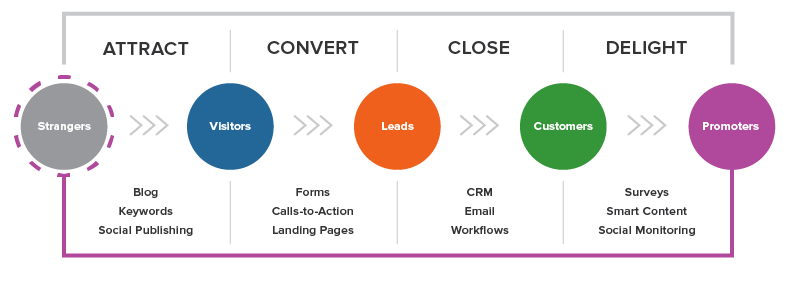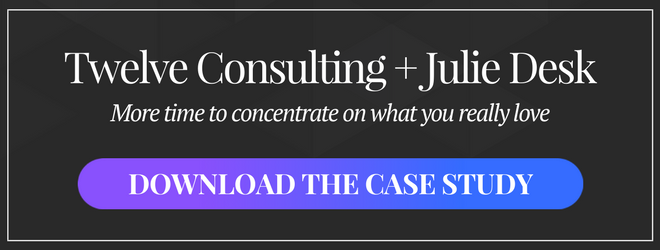In an article recently published on Linkedin, Aude Sibuet, Manager at Angie, critiques recent media coverage of “well-being at work.” Yoga classes and fresh fruit have been depicted as THE way to enhance employee experience, but that’s just a pretty picture. If you peel the paint away, you’ll see what’s really going on.
For some time there’s been this idea that companies should put aside cookie-cutter solutions like the one above and propose personalized solutions, whether they’re for employees or clients. Marketing departments have been working on this for years, building targeting solutions and automated marketing to personalize experiences.
So, what lessons can HR take from marketers to enhance employee experience?
A Paradigm shift
Back to basics 🙂 We all know that the perfect marketing mix is based on the famous 4Ps: Product, Price, Place and Promotion. Not to state the obvious, but access to information, networks and the digital revolution have made this concept obsolete. Today some cite an alternative, the 7-8Ps to replace them in this new digital landscape, but I’m proposing a new spin on the formula: The 4Es: Experience, Exchange, Everywhere, Evangelism.

You might be thinking, “that”s a good line, but what does that have to do with well-being at work?” Well they’re completely related!
Experience – Give employees more than just a job, give them real experiences
You should be giving employees more than just a job description. First of all, the jobs of the future don’t exist yet and secondly, the tasks or salary listed on a job description often evolve as you begin collaborating with colleagues. What you should sell is the company’s purpose, its values and its mission. We go back to the WHY that Simon Sinek addresses in his TED Talk when he says, “People don’t buy what you do, they buy why you do it.” Your employees aren’t with you for what you do, but why you do it!
Exchange – Don’t stop at salary
Salary isn’t enough. What counts is the value of what you’re proposing. Why do so many young graduates prefer joining startups; even going so far as to take a salary cut to do it?
There’s a huge movement to question the meaning of one’s work: employees need to be able to see their impact, see how they contribute to the realization of your company’s purpose. Which brings us back to our first point: if you don’t have a Why, it’ll be difficult to give meaning to what you do and retain talent.
Everywhere – Your colleagues are everywhere !
Digital has brought traditional work into question. No more fixed hours or fixed workspaces. Employees aspire to have more flexibility. They want to be in charge of their own use of time. Digital tools have made work nomadic.
American companies are highly advanced on the subject. WordPress recently announced the closing of its San Francisco offices. And Buffer, a social media company, has no offices but instead has employees dispersed around the world.
But leaving the office behind doesn’t meaning abandoning company culture. In fact, it’s the opposite! Company culture becomes more important when employees aren’t “physically“ collaborating everyday. As Buffer explains, for this to work, it should be in accordance with company values.
Evangelism – Your employees are your brand ambassadors
Digital has switched up the game. Brands no longer control messaging and thanks to social media, anyone can share their opinions (for better or for worse). At job interviews, candidates have already had access to a wealth of information about your company via sites like Glassdoor or Great Place to Work. Your employees can be your greatest brand ambassadors, or critics!
The employee-persona to propose a personalized employee experience
I recently spoke to a friend about all this and she said that all that is well and good but that at the end of the day, what motivates her is still salary. If having a purpose is imperative for some, for others, it’s just a supplement, and that’s not a critique. Everyone has their own specific needs and desires when it comes to work.
The psychologist Donald E. Super, created a list of 15 fundamental values that influence motivation at work:

Which brings us to a second concept that Human Resources representatives can use: the buyer persona.
Buyer personas are categorized portraits of clients (sex, age, profession, etc.), but they are also grouped by their objectives and behavior (the kinds of google searches they make etc.). These personas allow marketers to understand their target audiences better in order to make content that they can relate to. HR should use this to understand the ideal candidate for the company by facilitating: 1. the candidate search and 2.Their retention once they’ve been hired.
As we’ve seen, professional motivation is different for different people. Defining employee profiles will help HR propose a better employee experience. And that experience starts well before hiring and contract signatures.
How do I make these personas?
- Analysis of HR data: What are the journeys of most of your employees, their years of experience, their ages, etc.?
- Employee interviews: What are the motivations of current employees? You can give them Donald E. Super’s test on professional values to find out what they like or don’t like about the company, what they care about, what events they participate in, etc.
- Market research: Research on the current job market, schools, and profiles of competitors employees. Linkedin is a mine of precious information.
Once you’ve defined those personas, you can adapt your HR strategy to define the formats and channels that are best adapted to communicate your messages. For example, if you’re targeting junior profiles, don’t hesitate to use social media to find candidates.
From Inbound Marketing to Inbound HR
Inbound marketing is a strategy that makes the client come to you, as opposed to other marketing techniques that “push” messages to go find clients. This strategy, best described by Hubspot, is characterized by 4 principle steps : attract, convert, close, retain.

An interesting logic to apply to your candidates/colleagues!
Attract candidates
The objective here is to get on your prospective employees’ radar. Don’t limit yourself to a career page or post on your company website. Think to use social media for your recruiting campaigns. Participating in salons or forums is also a good way to attract future employees. Multiply the channels you use to attract candidates, as long as they target the personas you identify. How an external audience views your company plays an important role in this phase so keep an eye on how your employer brand is viewed.
Convert those candidates
In this phase, you need to make candidates want to contact you. Think about the offers you’re posting, about how they’re attractive for candidates and how they’re different from competitors’ offers.
In this phase, events are also an interesting tool: a quality event on an important subject tied to the problems your industry is facing can help you to identify potential future colleagues.
Recruit them (close the deal)
To close the deal and sign the employee contract, concentrate on your WHY. That’s what will give candidates a desire to join you. And again, don’t forget to use the persona’s to identify and recruit candidates that really interest you. Ask yourself, is management what interests the candidate more, or is it their relationships with colleagues? Is work environment important to them?
Retain and develop talent
In the face of a changing job market, the issue isn’t just knowing the work, but succeeding in continuously learning. Companies have an important role to play: they now have to incorporate training and increase certain skills. By enhancing employee experience in your company, you can transform employees into real brand ambassadors. Ambassadors that you can use to find new talent, convert them, recruit them and so on. 🙂
These approaches show how generic solutions are likely to fail and that in reality, working on employee experience demands a lot more than programming in-office yoga courses. One has to innovate and distinguish oneself from competitors to better answer employee needs.
And so to finish, I’ll leave you with this: If creativity is a key professional value for your employees, free them from thankless repetitive tasks so they can concentrate on what they really love:)

